International Demonstration Teaching Team
for the Course of Introduction to Dynamic Systems
一、课程简介
Introduction
《动态系统导论》(Introduction to Dynamic Systems)系西里西亚智能科学与工程学院电子科学与技术专业本科三年级学生的必修课程,该课程共计40学时,2.5学分,采用全英文教学模式,秋季学期开设。课程由波兰西里西亚技术大学与燕山大学电气工程学院中外双方教师联合授课。该课程以系统论为理论基础,融合了控制论、信息论和MATLAB仿真等内容,以解决工程领域的实际问题为导向,旨在培养学生的专业素养及创新思维,对实现专业培养目标具有重要支撑作用。
Introduction to Dynamic Systems is a compulsory course for third-year undergraduate students majoring in Electronic Science and Technology of the Silesian College of Intelligent Science and Engineering at Yanshan University. The course spans 40 teaching hours, carries 2.5 credits, and is delivered entirely in English during the autumn semester. It is jointly taught by faculty from the Silesian University of Technology in Poland and the School of Electrical Engineering at Yanshan University in China. The course is based on systems theory and integrates concepts from control theory, information theory, and MATLAB simulation. With a focus on addressing practical problems in engineering, it aims to cultivate students' professional competence and innovative thinking. It plays a critical supporting role in achieving the program's educational objectives.
二、团队成员
Team Member
Henryk Josinski,博士,担任《动态系统导论》课程的外方负责教师。现就职于西里西亚技术大学自动控制、电子与计算机科学学院,图形、计算机视觉与数字系统系副教授。主要研究方向包括人体再识别、局部动态稳定性研究、神经退行性疾病症状早期检测以及虚拟康复运行分析等领域。
Dr. Henryk Josinski,foreign teacher for Introduction to Dynamic Systems, associate professor from the Department of Graphics, Computer Vision and Digital Systems, Faculty of Automatic Control, Electronics, and Computer Science at the Silesian University of Technology. His primary research interests include human re-identification, local dynamic stability analysis, early detection of neurodegenerative disease symptoms and virtual rehabilitation performance analysis.
Damian Peszor,博士,担任《系统动力学导论》课程的外方教师。现就职于西里西亚技术大学自动控制、电子与计算机科学学院,图形、计算机视觉与数字系统系助理教授。主要研究方向包括视觉数据分析、运动数据分析、图像识别以及生物识别等领域。
Dr. Damian Peszor, foreign teacher for Introduction to Dynamic Systems, assistant professor from the Department of Graphics, Computer Vision, and Digital Systems, Faculty of Automatic Control, Electronics, and Computer Science at the Silesian University of Technology. His primary research interests include visual data analysis, motion data analysis, image recognition, and biometrics.
关哲,博士,担任《系统动力学导论》课程的中方共课教师。现就职于燕山大学电气工程学院,自动化系讲师。主要研究方向包括数据驱动理论、人工智能及其在工业领域的应用。主要讲授控制基础,预测控制等课程。
Dr. Guan Zhe, Chinese teacher for Introduction to Dynamic Systems, lecturer from the School of Electrical Engineering, Yanshan University. His primary research interests include data-driven theory, artificial intelligence and its applications in industrial fields. He mainly teaches courses such as Fundamentals of Control and Predictive Control.
三、团队合作
Teamwork
在课程开始前,中波双方教师依据中外联合课程规范化建设项目,针对课程进行了全面而细致的规划,明确了教学目标,并依据上一学期的教学反馈对内容进行了优化调整。此外,双方教师通过电子邮件的方式,就教学安排、教学体量的合理调整及学生跨文化交流能力的培养等方面,进行了积极且有效的沟通与交流。
Before the start of the course, Chinese and Polish faculty members conducted comprehensive and detailed planning based on the Sino-foreign joint course standardization project. They clarified the teaching objectives and optimized the content according to feedback from the previous semester. Furthermore, the Chinese and Polish teachers engaged in active and effective communication via email in terms of teaching arrangements, reasonable adjustments to the course load and the cultivation of students' cross-cultural communication skills.
波方教师抵达中国后,院方组织了一场中波教师联合座谈会。在这次会议中,双方教师深入探讨并进一步明确了教学内容的具体细节,详细确认了课程的课时分配、组织形式以及考核方式等关键教学安排。通过这次座谈会,双方教师达成了一致意见,确保了课程教学工作的顺利开展。图1和图2为中外双方教师座谈会后合影。
After the Polish faculty members arrived in China, the college organized a Sino-Polish faculty exchange meeting in which the two sides had an in-depth discussion and further clarified the details of the course content and confirmed key teaching arrangements such as teaching hours allocation, organizational form and assessment methods of the course. Through this meeting, the two sides reached a consensus and ensured the smooth development of teaching.
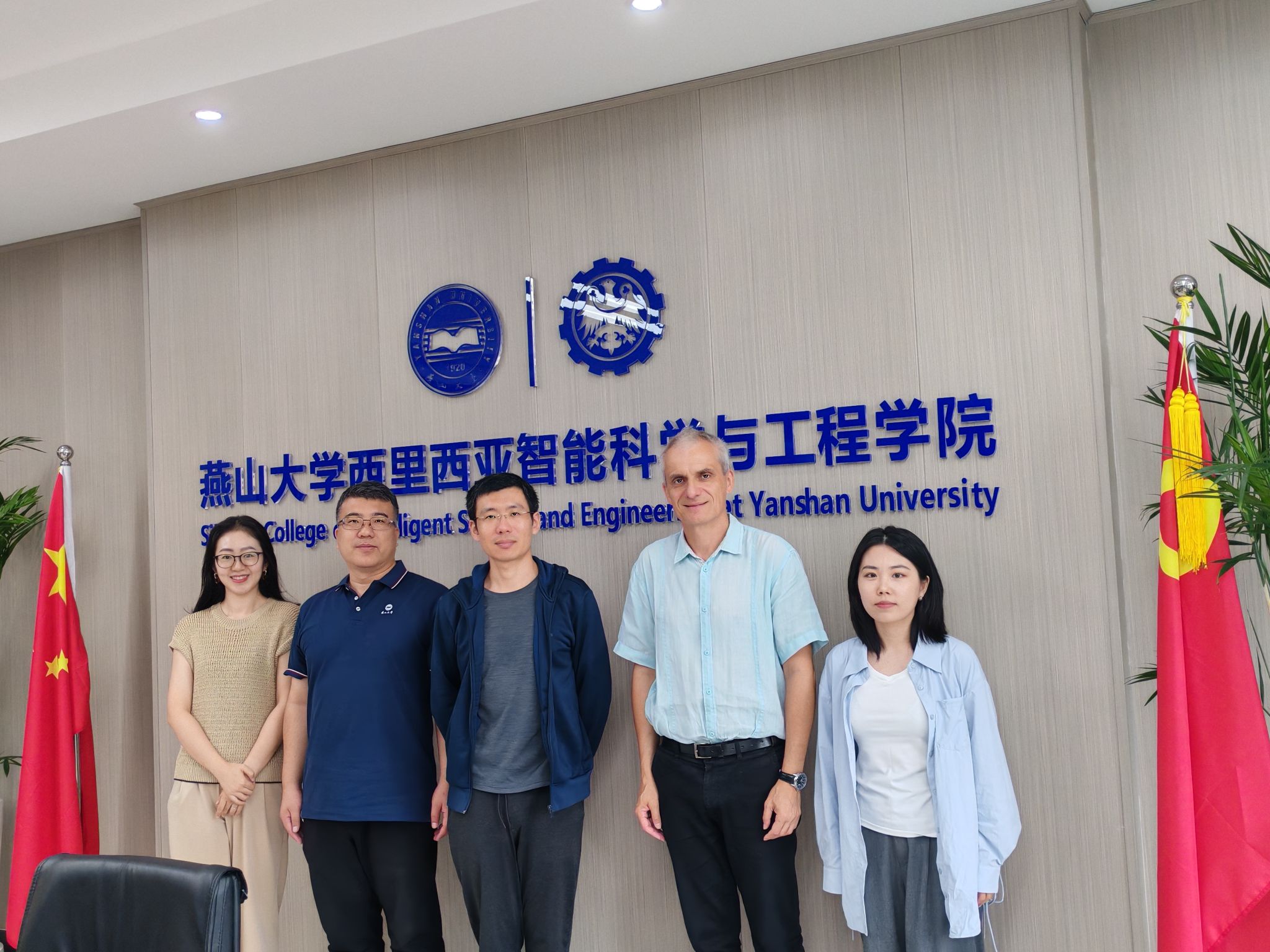
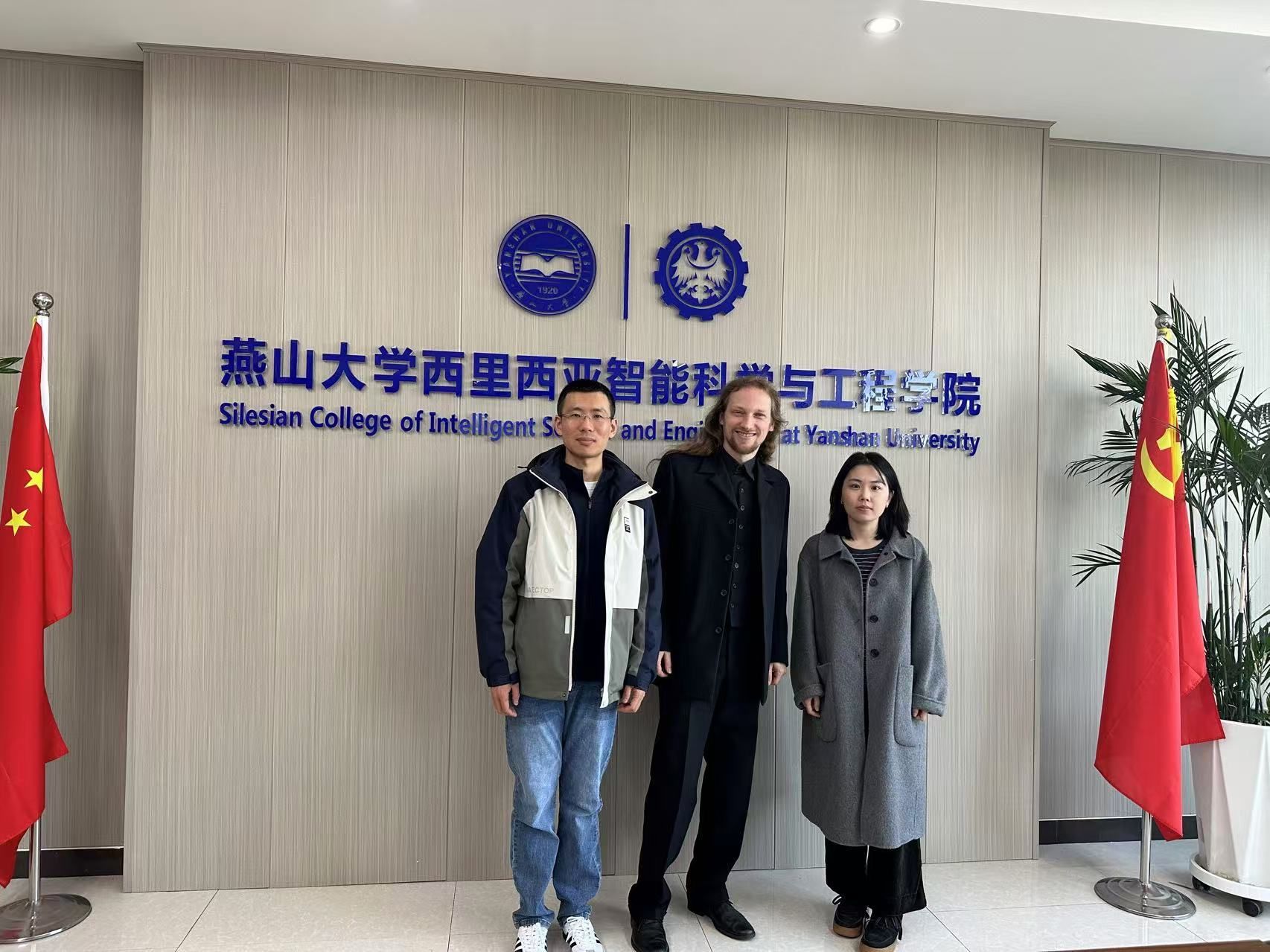
图1 中外双方教师合影 图2 中外双方教师合影
Figures 1 and 2 show the group photos taken after the Sino-foreign faculty exchange meeting.
在授课过程中,Henryk博士负责课程理论知识的讲授,图3为Henryk博士授课的照片。他不仅将波兰西里西亚技术大学的独特风格和文化融入到教学中,还积极引导学生在课堂上踊跃发言和参与讨论。这种互动式教学方法使得学生们能够对课堂内容有更深入的理解和掌握。Damian博士负责实验习题部分的讲授,图4为Damian博士上课的照片,图5为Damian博士和关哲博士同学生讨论问题的照片。他通过循序渐进的方式,详细分解题目的每一步骤,引导学生深入思考问题的求解过程,特别强调理论知识在实际应用中的重要性。
Dr. Henryk was responsible for delivering the theoretical knowledge of the course. Figure 3 shows a photo of Dr. Henryk teaching.He not only incorporated the unique style and culture of Silesian University of Technology into his lectures but also actively encouraged students to participate in discussions and express their ideas in class. The interactive teaching approach enabled students to gain a deeper understanding and a better grasp of the course content. Dr. Damian oversaw instructing experimental exercises.
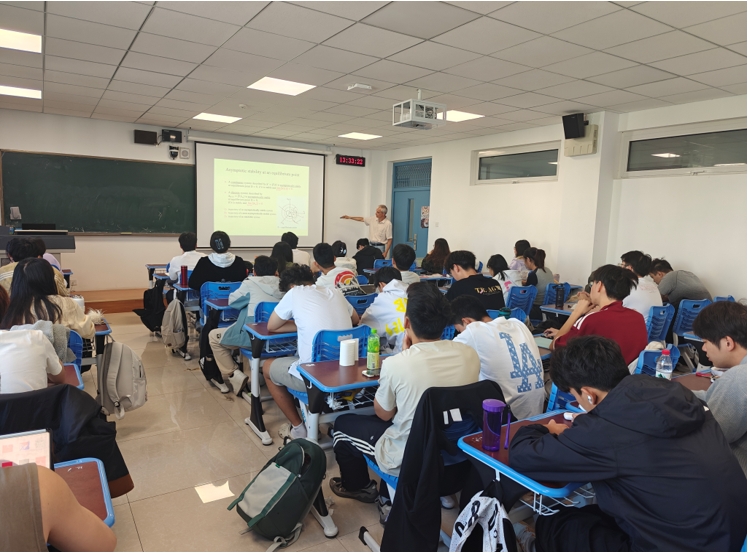
图3 Henryk博士授课
Figure 3 shows a photo of Dr. Henryk teaching.
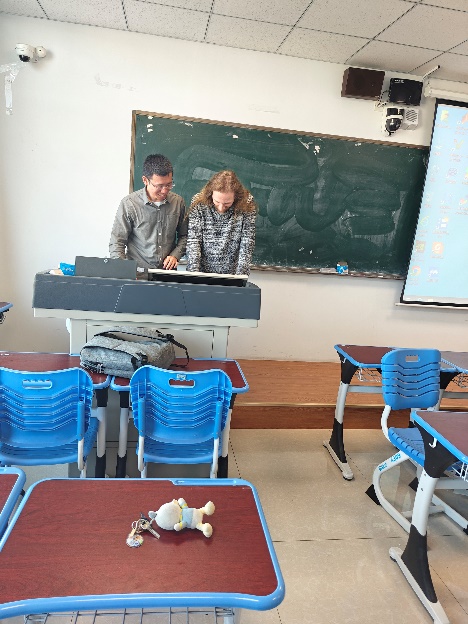
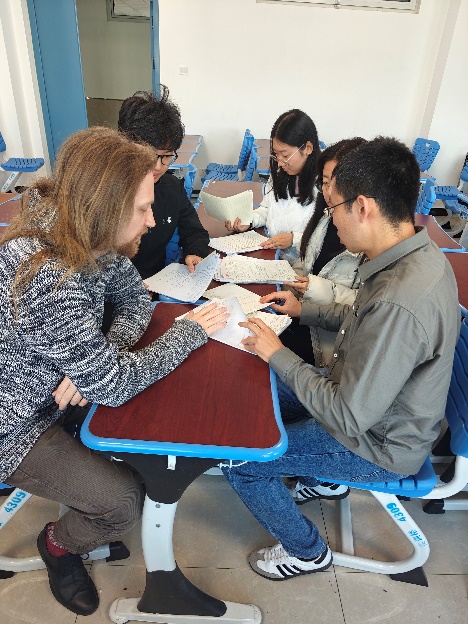
图4 Damian博士授课照片 图5 Damian博士和关哲博士同学讨论
Figure 4 shows a photo of Dr. Damian teaching and Figure 5 captures a moment of Dr. Damian and Dr. Guan Zhe discussing problems with students.
Dr. Damian broke down each exercise step-by-step in a progressive manner, guiding students to think deeply about problem-solving processes while emphasizing the importance of applying theory into practice.
课后,中方助教老师会借助学习通教学平台(图6),向学生发送课程相关资料,并解答学生提出的问题。助教老师还将及时与外教沟通,确保外教能够根据学生们的反馈对课程内容进行及时的调整和优化。此外,中方助教老师还会密切关注学生们的学习基础及对这门课程的学习情况,依据学生的实际需求提供针对性的学习建议。为了更好地了解学生的学习情况,课程还特别设定了2次课堂测试和2次课后报告。另外,中方助教老师还安排了一堂答疑课,如图7。这些评估机制有助于教师实时掌握学生的学习进度和理解程度,从而更好地指导学生的学习。
After class, the Chinese teacher utilized the XueXiTong teaching platform (Figure 6) to distribute course materials and help answer students' questions. The Chinese teacher also communicated with the foreign teacher in a timely manner to ensure that the foreign teacher can adjust and optimize the course content based on the feedback of students Additionally, the Chinese teacher paid close attention to students’ learning foundation and their progress in the course and offered targeted learning suggestions according to their needs. To better understand students' learning situation, the course incorporated two in-class tests and two after-class reports. Moreover, the Chinese teacher also organized a Q&A class, as shown in Figure 7. Those evaluation mechanisms helped both the Chinese and the foreign teachers timely track students' learning progress and understanding to give more effective guidance for students.
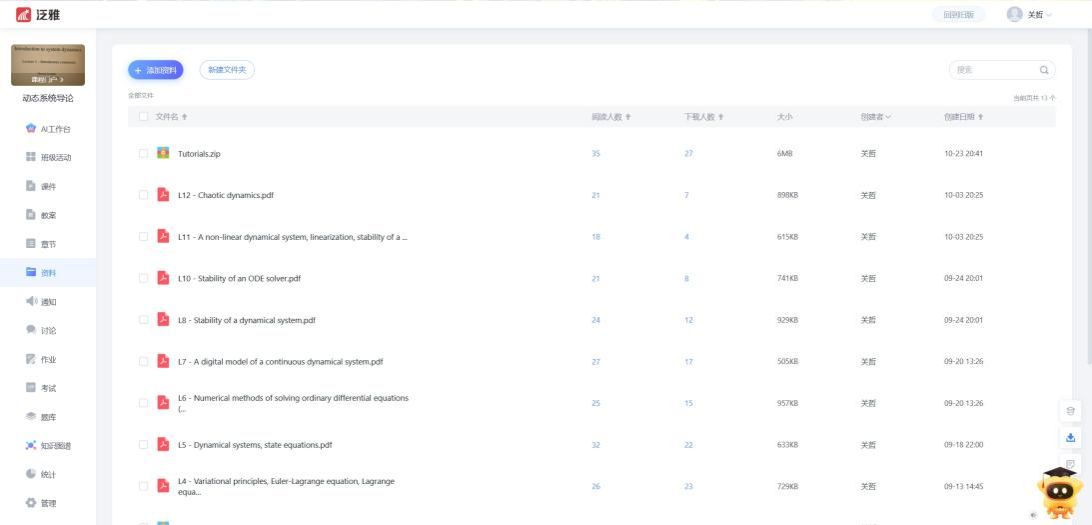
图6 学习通教学平台
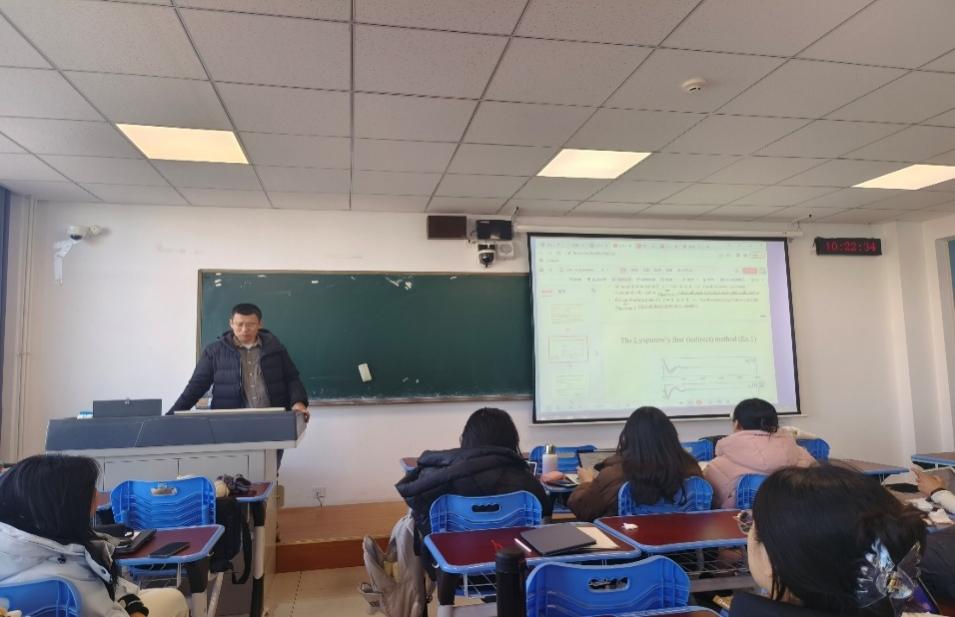
Figure 7 shows Dr. Guan Zhe giving the Q&A class
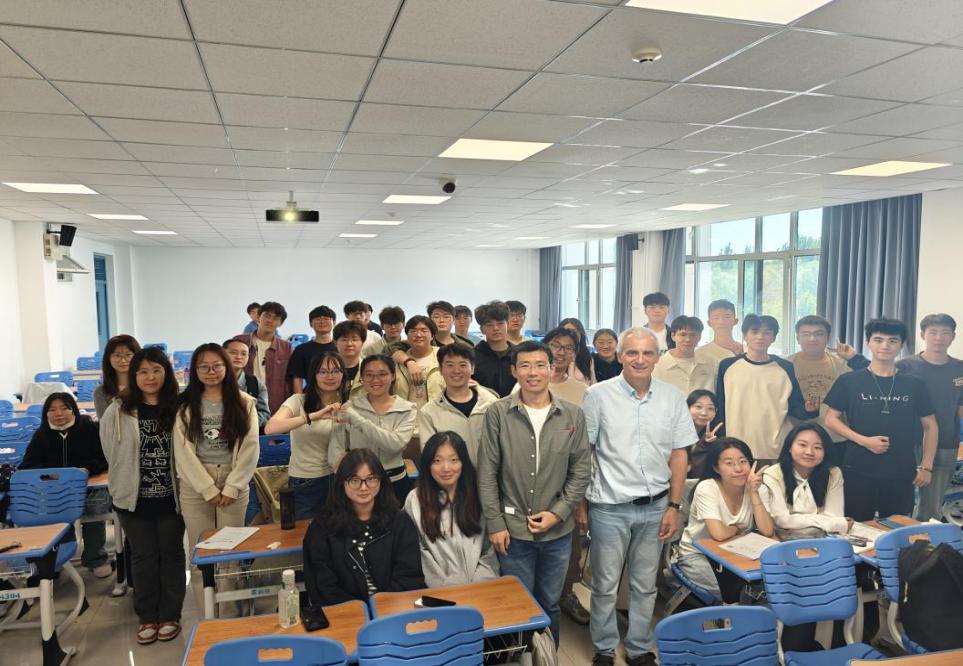
图8 全体合影
Figure 8: Group Photo of the class
四、课程内容
Course Information
《动态系统导论》课程以系统论为理论基础,将控制论、信息论以及MATLAB仿真等多方面的知识内容有机地融合在一起,是一门综合性较强的专业课。整个课程分为两个主要部分:理论课程和实验课程。理论课程共计12次课,涵盖了系统动力学的核心概念、基本原理和应用方法等内容,帮助学生建立起系统的理论框架。实验课程共计8次,通过MATLAB仿真,让学生在实践中加深对理论知识的理解和应用,提高动手能力和解决实际问题的能力。
The Introduction to Dynamic Systems is based on systems theory, integrating knowledge from various fields such as cybernetics, information theory, and MATLAB simulation. It is a highly comprehensive professional course. The curriculum is divided into two main parts: theoretical and laboratory classes. The theoretical part consists of 12 classes, covering core concepts, fundamental principles and application methods of system dynamics with the aim of helping students build a systematic theoretical framework. The laboratory part includes 8 classes. Through MATLAB simulation, students can deepen their understanding and application of theoretical knowledge in practice and improve their hands-on ability and ability to solve practical problems.
理论课程内容:
Theoretical Course Content:
Lecture 1 - Introductory comments
主要介绍了系统动力学(System Dynamics)的基本概念、建模过程、数学模型的定义和分类、模型的构建和分析方法,以及如何通过计算机模拟来研究动态系统。系统动力学是研究动态系统行为和响应分析的数学建模方法,目的是理解和改善系统性能。本次课强调了数学模型在预测未来事件、优化控制和设计行动中的应用,以及如何通过数学语言更好地理解和验证生物机制。
Lecture 1 primarily introduces fundamental concepts of system dynamics, including modeling process, definition and classification of mathematical models, model construction and analysis methods. It also explores how to study dynamic systems through computer simulation. System dynamics is a mathematical modeling approach which studies the behavior and response analysis of dynamic systems for the purpose of understanding and improving system performance. The course emphasizes the application of mathematical models in predicting future events, optimizing control, and designing actions. Additionally, it highlightshow biological mechanisms can be better understood and verified through mathematical language.
Lecture 2 - Method of balances
主要介绍了系统动力学的基本原理和方法,包括平衡方法、守恒定律以及状态空间表示法。首先解释了“仓库”概念,即系统中能够存储一定量的部分,并通过水箱示例展示了流量平衡。接着,讨论了电路和机械系统中的自然状态变量,如电容器的电压和电感器的电流,以及基尔霍夫电流和电压定律。此外,还涉及了机械系统中质量、弹簧和阻尼器的作用,并通过牛顿定律建立了力与加速度、位移和速度之间的关系。最后,通过一个完全混合反应器的化学过程示例,展示了如何应用质量守恒定律来建立数学模型。
Lecture 2 introduces fundamental principles and methods of system dynamics, including balance method, conservation laws and state-space representation. The class begins with the concept of a "reservoir," namely the part of a system which can store quantities and demonstrates the flow balance through an example of water tank. Next, it covers natural state variables in electrical and mechanical systems, such as the voltage across capacitors, current through inductors and the application of Kirchhoff's current and voltage laws. The roles of mass, springs, and dampers in mechanical systems are discussed and the relation among force, acceleration, displacement and velocity is established through Newton’s laws. Finally, a chemical process example involving a fully mixed reactor is demonstrated to show how to apply the law of mass conservation to construct mathematical models.
Lecture 3 - Electro-mechanical analogies between elements and between systems
主要介绍了系统动力学中的模拟方法,特别是机电类比。首先概述了模拟模型的概念,即使用与实际过程在某种程度上相似的元素来代表过程。接着,详细讨论了机电系统之间的两种类比类型,包括元素之间的类比和系统之间的类比。还提供了电气电路和机械系统中“自然”状态变量的列表,例如电容器上的电压和电感器中的电流,以及机械系统中的位移和速度。此外,还详细列出了两种类型类比中元素的对应关系,如质量对应电感,弹簧对应电容,阻尼器对应电阻等。最后,通过几个例子展示了如何将机械系统转换为对应的电气电路,并给出了两种类型类比的总结和规则。
Lecture 3 focuses on simulation methods in system dynamics, with a particular emphasis on electromechanical analogies. The class begins with an overview of simulation model representing processes using elements that are somewhat like actual processes. Thentwo kinds of ratios between electromechanical systems are discussed including element analogies and system analogies. A detailed list of "natural" state variables is provided for both electrical circuits and mechanical systems, such as voltage across capacitors, current through inductors, displacement and velocity in mechanical systems. The corresponding relations between elements in the two analogy types are explained such as mass corresponding to inductance, spring corresponds to capacitance and damper corresponds to resistance. Finally, several examples are demonstrated to explain how mechanical systems can be converted into their equivalent electrical circuits. The summary and rules for both types of analogies are also provided to guide the application of these methods effectively.
Lecture 4 - Variational principles, Euler-Lagrange equations, Lagrange equations
主要介绍了系统动力学的基础知识,包括变分原理、欧拉-拉格朗日方程和拉格朗日方程。首先通过费马最小时间原理阐述了自然现象的优化过程,例如光线在两点间传播时会选择最短时间路径。接着,探讨了费马原理在反射和折射现象中的应用,解释了光线在平面镜反射和不同介质间折射时遵循的路径。此外,还涉及了哈密顿原理,即保守系统在特定时间内从初始状态到最终状态的轨迹是使得作用量积分最小的路径。最后,通过欧拉-拉格朗日方程和拉格朗日方程,展示了如何从变分原理出发,建立动力学系统的数学模型。这些原理和方程为理解和描述物理现象提供了强有力的数学工具。
Lecture 4 introduces fundamental concepts of system dynamics, including variational principle, Euler-Lagrange equation and Lagrangian mechanics. It firstly introduces the optimization process of natural phenomena by using Fermat's minimum time principle, for example, light chooses the path that requires the least time to travel between two points. Then the application of Fermat's principle is explored in reflection and refraction. It also illustrates the paths that light follows when reflecting off a plane mirror or reflection between different media. Hamilton's principle is introduced, which states that the trajectory of a conservative system from an initial state to a final state over a specific time interval is the one that minimizes the action integral. Finally, the teacher demonstrates how the Euler-Lagrange equation and Lagrangian mechanics can be derived from the variational principle to construct mathematical models of dynamic systems. These principles and equations serve as powerful mathematical tools for understanding and describing physical phenomena.
Lecture 5 - Dynamical systems, state space, state equations
主要介绍了系统动力学的基础知识,包括动力系统的定义、状态空间表示、状态方程和输出方程。动力系统是数学的一个分支,研究由一组一致的定律随时间变化的系统,这些定律通常由微分方程或差分方程描述。动力系统可以是连续的、离散的、离散事件系统或混合系统。本次课还讨论了初始值问题,即给定一个初始条件,寻找一个函数作为解的数学问题。此外,通过Lanchester战斗模型的例子,展示了如何将二阶微分方程转换为一阶状态方程组,并通过计算机模拟来分析系统的演化。最后,区分了连续线性系统和离散线性系统的状态方程,并通过例子说明了它们的计算方法。
Lecture 5 introduces foundational knowledge of system dynamics, including the definition of dynamical systems, state-space representation, state equations and output equations. Dynamical system is a branch of mathematics that studies the system that evolves over time according to a set of consistent laws. Those laws are typically described by differential or difference equations. Dynamical systems can be categorized as continuous, discrete, discrete event or hybrid systems. The lecture also covers the initial value problem, namely the mathematical problem of finding a function as a solution given an initial condition. Through the example of the Lanchester combat model, the teacher illustrates how to transform a second-order differential equation into a set of first-order state equations and to analyze system evolution through computer simulation. Finally, the teacher distinguishes between continuous linear systems and discrete linear systems in terms of their state equations, providing examples to demonstrate their respective computation methods.
Lecture 6- Numerical methods of solving ODE
主要介绍了系统动力学的基础知识,包括数字模型的构建、模拟实验的目的和过程,以及如何使用数值方法解决常微分方程(ODE solvers)。课件详细阐述了连续线性动力系统的状态方程和输出方程,以及如何通过数值积分公式逐步计算状态变量的近似值,从而追踪近似数值解的轨迹。此外,还讨论了欧拉方法和龙格-库塔方法等数值解法的基本原理和步骤,包括固定步长和变步长、显式和隐式方法、单步和多步方法。特别地,提到了ode 45,这是一种基于Dormand-Prince策略的四阶和五阶自适应步长方法,被推荐为大多数问题的首选方法。最后,课件还涉及了预测-校正方法,这是一种结合了显式和隐式技术的数值解法。
Lecture 6 covers foundational knowledge of system dynamics, including digital modeling, the purpose and process of simulation experiments and ordinary differential equations solving (ODEs) through numerical methods. The lecture explains state and output equations of continuous linear dynamical systems and how to use numerical integration formulas to iteratively calculate approximate values of state variables, enabling the tracking of the trajectory of approximate numerical solutions. Key numerical methods, such as the Euler method and Runge-Kutta methods are discussed in detail, including fixed-step and variable-step approaches, explicit and implicit methods and single-step and multi-step techniques. Particular attention is given to the ode45 solver, an adaptive step-size method based on the Dormand-Prince strategy combining fourth- and fifth-order Runge-Kutta methods. It is recommended as the default choice for most problems due to its efficiency and reliability. Finally, the lecture introduces predictor-corrector methods which combine explicit and implicit techniques for improved numerical accuracy and stability.
Lecture 7 - A digital model of continuous dynamical system
主要介绍了系统动力学的数字化模型构建方法。首先,课件强调了从现象到数字模型的转换过程,包括使用平衡法、类比法以及建立微分方程(ODE)等数学模型。接着,课件详细阐述了状态方程系统的构成,包括状态变量的一阶导数定义、数值积分公式、初始条件设置以及结果展示等关键组成部分。此外,课件还提供了使用MATLAB软件进行动态系统模型设计、运行、结果可视化和系统行为验证的指导。具体到MATLAB中的ode45函数,课件展示了如何通过编写状态方程函数来求解连续系统的动态行为,并通过图形化的方式展示数值解和解析解之间的差异。
Lecture 7 primarily introduces digital modeling methods in system dynamics. Firstly, it emphasizes the transformation process from phenomena to digital models, including the use of balance methods, analogy methods and mathematical models such as ordinary differential equations (ODEs). Then, it elaborates on the components of the state equation system, covering key elements like the definition of first-order derivatives of state variables, numerical integration formulas, initial condition settings and result presentation. Additionally, it provides guidance in using MATLAB software for designing, running, visualizing results and verifying the behavior of dynamic system models. Regarding MATLAB's ode45 function, the material demonstrates how to solve the dynamic behavior of continuous systems by writing state equation functions and visualizes the differences between numerical and analytical solutions using graphical methods.
Lecture 8&9 - Stability of a dynamical system
主要介绍了系统动力学中的稳定性概念,包括连续和离散系统的稳定性分析。课件首先通过多个实例(如船舶在风暴中的稳定性、飞机在强风中的稳定性、摆动的摆、经济趋势的稳定性、神经系统对压力的稳定性等)说明了不同系统对小扰动的反应,强调了系统恢复平衡状态的能力。接着,课件定义了稳定性,并提到了数学中稳定性理论的应用,包括微分方程和动力系统轨迹在初始条件小扰动下的稳定性。课件还详细讨论了平衡点的概念,以及如何通过特征方程来判断系统的稳定性。最后,课件通过例子展示了如何应用赫尔维茨稳定性准则来分析线性连续系统和离散系统的稳定性。
Lecture 8&9 primarily introduces the concept of stability in system dynamics, covering stability analysis for both continuous and discrete systems. The lecture begins with illustrating the responses of various systems to small disturbances through multiple examples (such as a ship's stability in a storm, an aircraft's stability in strong winds, the oscillation of a pendulum, economic trend stability and the nervous system's resilience to stress) and emphasizes the ability of systems to return to an equilibrium state. Next, it defines stability and highlights the application of stability theory in mathematics, including the stability of solutions to differential equations and trajectories of dynamical systems under small perturbations of initial conditions. The lecture also delves into the concept of equilibrium points and how to determine system stability by using characteristic equations. Finally, examples are provided to demonstrate the application of the Hurwitz stability criterion in analyzing the stability of linear continuous and discrete systems.
Lecture 10 - Stability of an ODE solver
本次课主要介绍了系统动力学中的常微分方程(ODE)求解器的稳定性问题。首先,定义了数值稳定性,即计算过程不会放大近似误差。接着,通过特征方程的根条件来判断求解器的稳定性,即所有特征方程的根必须位于或在单位圆的边界上,且边界上的根必须是单根。本次课还提供了一个通用的ODE求解器公式,并讨论了当步长h趋近于0时,数值解会接近解析解,即收敛性。此外,还探讨了绝对稳定性(alpha-稳定性),这是一种评估ODE求解器的全局标准。通过测试方程和ODE求解器的公式,可以构造一个差分方程,用于评估求解器的绝对稳定性。最后,本次课通过Euler方法的绝对稳定性区域示例,说明了如何使用MATLAB代码来可视化结果,并讨论了显式方法的条件稳定性,即存在一个临界步长h,超过这个步长数值不稳定性就会出现。
Lecture 10 focuses on the stability issues of ordinary differential equation (ODE) solvers in system dynamics. It begins by defining numerical stability, which ensures that the computational process does not amplify approximation errors. It then explains how to determine solver stability using the root conditions of the characteristic equation: all roots must lie within or on the boundary of the unit circle, and any roots on the boundary must be simple. It also introduces a general formula for ODE solvers and discusses convergence, discussing that as the step size ℎ approaches zero, the numerical solution converges to the analytical solution. It also explores absolute stability (alpha-stability), a global criterion for assessing ODE solvers. By using a test equation and the ODE solver formula, a difference equation can be constructed to evaluate the solver's absolute stability. Finally, it provides an example of the absolute stability region for the Euler method, illustrating how to use MATLAB code to visualize the results and highlighting the conditional stability of explicit methods, that is, there is a critical step size ℎ beyond which numerical instability occurs.
Lecture 11 - A non-linear dynamical system, linearization, stability of a non-linear system
主要介绍了系统动力学中的非线性动力系统,包括非线性系统的线性化方法和稳定性分析。非线性系统的特点是其状态变量的时间演化规律与变量值的非线性关系有关,而线性系统则遵循叠加原理。本次课中提到了如何通过泰勒级数展开对非线性系统进行线性化,并在操作点附近进行稳定性分析。此外,还介绍了Lyapunov稳定性理论,包括Lyapunov的第一(间接)方法和第二(直接)方法,用于判断非线性系统的稳定性。通过实例演示了如何应用这些方法来分析特定的非线性系统,例如Lanchester模型和Volterra-Lotka模型。最后,本次课还提供了一个MATLAB代码示例,用于模拟非线性系统的动态行为。
Lecture 11 introduces nonlinear dynamical systems in system dynamics, including linearization methods and stability analysis. The characteristic of nonlinear system is that the time evolution law of state variables is related to the nonlinear relationship of variable values, while linear system follows the superposition principle. It explains how to linearize nonlinear systems by using a Taylor series expansion and perform stability analysis near the operating point. It also introduces Lyapunov stability theory, including Lyapunov's first (indirect) method and second (direct) method, to assess the stability of nonlinear systems. Examples, such as the Lanchester model and the Volterra-Lotka model, are used to demonstrate the application of these methods to analyze specific nonlinear systems. Finally, a MATLAB code example is provided to simulate the dynamic behavior of nonlinear systems, offering practical insights into their analysis.
Lecture 12 - Chaotic dynamics
介绍了系统动力学,特别是混沌动力学的相关内容。混沌理论是数学的一个分支,专注于研究动态系统背后的模式和确定性法则,这些系统对初始条件极为敏感。混沌系统通常由确定性方程描述,但其解看起来像是随机的,这种现象被称为“确定性混沌”。混沌系统必须是非线性的,对于连续系统,至少需要三维空间;而离散系统无论维度如何,都可能表现出混沌行为。洛伦兹系统是用于大气对流的数学模型,由爱德华·洛伦兹在1963年偶然发现,他发现即使是微小的初始条件差异,也会导致结果的巨大差异,这就是著名的“蝴蝶效应”。混沌系统具有奇怪的吸引子,它们在局部不稳定但在全局稳定,即轨迹会相互远离但不会无限增长。混沌动力学在自然现象中具有重要应用,例如心脏节律的混沌行为与健康状态有关,而混沌控制可以通过微调控制参数来实现系统行为的有益变化。
Lecture 12 delves into system dynamics, particularly focusing on chaotic dynamics. Chaos theory, a branch of mathematics, investigates the patterns and deterministic laws underlying dynamic systems which are extremely sensitive to initial conditions. Chaotic systems are typically described by deterministic equations, yet their solutions often appear random—a phenomenon known as “deterministic chaos”.
Nonlinearity is a prerequisite for chaos. Continuous systems require at least three dimensions to exhibit chaotic behavior, However, discrete systems can display chaos regardless of dimensionality. The Lorenz system, a mathematical model for atmospheric convention, was discovered by Edward Lorenz in 1963. It demonstrated that even tiny differences in initial conditions could lead to vastly different outcomes, which is a concept famously known as the butterfly effect. Chaotic systems feature strange attractors, which are locally unstable but globally stable. This means trajectories diverge from one another but remain bound and do not grow infinitely. Chaos theory has significant applications in natural phenomena. For instance, the chaotic behavior of heart rhythms can indicate health conditions, and chaos control allows beneficial changes in system behavior through fine-tuning of control parameters.
实验课程内容:
Laboratory Course Content:
Tutorial 1 - Euler-Lagrange equation - examples
详细介绍了系统动力学和拉格朗日方程的应用。通过垂直运动和电路系统的例子,展示了如何使用拉格朗日方程来描述系统的动力学行为。本次课提到了动能和势能存储元件,如质量电感器、弹簧和电容器,并讨论了阻尼电阻器作为能量耗散元件。在垂直运动的例子中,考虑了一个质量为m的物体从高度h处自由下落的情况,忽略了空气阻力,并给出了运动方程。在电路的例子中,分析了一个包含电感器、电容器和电阻器的电路系统,使用拉格朗日方程来推导出系统的运动方程,并验证了基尔霍夫电压定律。
The tutorial provides a detailed introduction to system dynamics and the application of the Lagrange equation. By using examples of vertical motion and electrical circuits, it demonstrates how to use the Lagrange equation to describe the dynamic behavior of systems. It mentions kinetic and potential energy storage elements such as mass inductors, springs, and capacitors, and discusses damping resistors as energy-dissipating elements. In the example of vertical motion, the case of an object of massmfalling freely from heighthis considered, air resistance is ignored, and the equation of motion is given. In the circuit example, a circuit system containing inductors, capacitors, and resistors is analyzed. Lagrange equations are used to derive the equations of motion of the system and Kirchhoff's voltage law is verified.
Tutorial 2 - Ordinary differential equations
详细介绍了常微分方程(ODE)的理论和解法。首先,本次课解释了初值问题(IVP)的概念,即在给定初始条件下求解微分方程的问题。接着,课件定义了微分方程的阶数,并区分了一般解和特解的概念。本次课通过具体例子展示了如何求解一阶和二阶的齐次与非齐次微分方程,包括使用分离变量法和待定系数法。此外,本次课还讨论了线性常系数微分方程的解法,包括特征方程的构造和求解,以及如何根据特征方程的根来确定解的结构。
The tutorial provides a detailed introduction to the theory and methods for solving ordinary differential equations (ODEs). Firstly, the concept of the initial value problem (IVP) is explained, which involves solving a differential equation with given initial conditions. Next, the tutorial defines the order of a differential equation and distinguishes between the general solution and particular solution. Through specific examples, it demonstrates how to solve first-order and second-order homogeneous and non-homogeneous differential equations, including methods of separation of variables and undetermined coefficients. Additionally, the tutorial discusses the solution methods for linear differential equations with constant coefficients, including constructing and solving the characteristic equation and determining the structure of the solution based on the roots of the characteristic equation.
Tutorial 3 - Methods for constructing state equations
详细介绍了构建状态方程的方法,包括解析和数值解法。对于高阶微分方程,可以通过引入新的状态变量将其转换为一阶系统。本次课还讨论了线性连续系统的数学模型,如高阶微分方程和传递函数,并提供了状态空间表示的示例。特别地,对于含有输入信号导数的微分方程,本次课展示了连续积分法和混合方法的应用。最后,强调了在数字模型中为状态变量分配初始值的重要性。
The tutorial provides a detailed introduction to the methods for constructing state equations, including both analytical and numerical approaches. For high-order differential equations, it explains how to transform them into a first-order system by introducing new state variables. It also discusses the mathematical models for linear continuous systems, such as high-order differential equations and transfer functions, and provides examples of state-space representations. Particularly, for differential equations involving the derivatives of input signals, it demonstrates the application of continuous integration methods and hybrid methods. Finally, it emphasizes the importance of assigning initial values to state variables in digital models.
Tutorial 4 - Discrete state equations
主要介绍了系统动力学的基础知识,包括离散状态方程的教程。本次课通过一个关于大学附近三家外卖餐厅(Pizza Paradise、Quick Burger和Noodles Unlimited)的案例,展示了如何使用状态方程来预测顾客的长期趋势。通过建立状态转移矩阵,计算了顾客在不同餐厅之间的转移概率,并使用MATLAB代码来模拟这一过程。此外,还探讨了Leslie模型,这是一种用于描述人口结构变化的离散线性系统模型,并通过MATLAB进行了实现。最后,本次课还涉及了离散非线性系统的状态方程,以捕食者-猎物模型(Lotka-Volterra方程)为例,说明了如何分析和模拟生态系统中的动态变化。
This tutorial mainly introduces the basics of system dynamics, including a tutorial on discrete state equations. Through case study of three food delivery restaurants (Pizza Paradise, Quick Burger, and Noodles Unlimited) near a university, it demonstrates how to use state equations to predict long-term customer trends. By constructing a state transition matrix, the transition probabilities of customers between different restaurants are calculated, and MATLAB code is used to simulate this process. Additionally, it explores the Leslie model, a discrete linear system model used to describe population structure changes and implements it through MATLAB. Finally, it also covers state equations for discrete nonlinear systems, using the predator-prey model (Lotka-Volterra equations) as an example to explain how to analyze and simulate dynamic changes in ecosystems.
Tutorial 5 - Analysis of stability of a dynamical system - examples
主要介绍了系统动力学中的稳定性分析。首先,通过重复基本术语,解释了稳定性是系统在受到小扰动后能否恢复平衡状态的能力。接着,详细讨论了线性连续/离散系统的稳定性条件,包括渐近稳定性的根条件和区域稳定性。通过实例分析,本次课展示了如何使用特征方程、Hurwitz准则和MATLAB工具来判断线性连续系统的稳定性。此外,还探讨了非线性连续系统的稳定性,通过线性化方法和Lyapunov第一方法来近似系统动态,并分析了在平衡点处的稳定性。
This tutorial focuses on stability analysis in system dynamics. Firstly, by repeating fundamental terms, it explains stability as the system's ability to return to equilibrium after small disturbances. Then it discusses the stability conditions for linear continuous and discrete systems in detail, including root conditions for asymptotic stability and regional stability. Through example analyses, it demonstrates how to use the characteristic equation, Hurwitz criterion, and MATLAB tools to assess the stability of linear continuous systems. Furthermore, it explores the stability of nonlinear continuous systems by approximating system dynamics through linearization and Lyapunov's first method and analyzing stability at equilibrium points.
Tutorial 6 - MATLAB
主要介绍了MATLAB的基础操作和控制流语句,包括输入输出操作、脚本和函数、绘图等。MATLAB是一种编程语言,由MathWorks公司开发,广泛应用于工程计算、数据分析、算法开发等领域。本次课提到了MATLAB的多个工具箱,如曲线拟合、符号计算、优化、统计和机器学习等。此外,还涉及了MATLAB的矩阵操作,包括矩阵的创建、转置、维度、元素操作等。本次课还展示了如何使用MATLAB进行基本的数学运算,包括复数运算、三角函数、指数函数等。最后,本次课通过示例演示了如何使用MATLAB进行脚本编写和函数定义,以及如何创建和使用2D和3D图形。
This tutorial introduces the basics of MATLAB operations and control flow statements, including input/output operations, scripts, functions, and plotting. MATLAB, a programming language developed by MathWorks, is widely used in engineering computations, data analysis, algorithm development, and more. This tutorial highlights several MATLAB toolboxes, such as curve fitting, symbolic computation, optimization, statistics, and machine learning. It also covers matrix operations in MATLAB, including matrix creation, transposition, dimensions, and element-wise operations. The tutorial demonstrates how to perform basic mathematical operations using MATLAB, including complex number calculations, trigonometric functions, and exponential functions. Finally, through examples, it shows how to write scripts and define functions in MATLAB and create and utilize 2D and 3D graphics.
Tutorial 7 - MATLAB - exercises
介绍了系统动力学的基础知识,并通过三个示例模型来阐述其应用。第一个模型是一个简化的流行病模型,它考虑了健康易感人群和患病人群的动态变化,以及疾病通过直接接触传播的机制。第二个模型是药物在人体内的吸收过程,涉及药物在胃肠系统和血液中的质量变化。第三个模型是Rössler混沌系统,展示了系统对初始条件的极端敏感性。每个模型都包括状态方程、模型参数、实验参数和MATLAB代码实现,用于模拟和分析系统行为。
This tutorial introduces the fundamentals of system dynamics and demonstrates its applications through three example models. The first model is a simplified epidemic model that considers dynamic changes in susceptible and infected populations and the mechanism of disease transmission through direct contact. The second model addresses the absorption process of drugs in the human body, focusing on the mass variation of drugs in the gastrointestinal system and bloodstream. The third model is the Rössler chaotic system, showcasing the extreme sensitivity of the system to initial conditions. Each model includes state equations, model parameters, experimental parameters and MATLAB code implementations to simulate and analyze system behaviors.
Tutorial 8 - MATLAB/Simulink
主要介绍了系统动力学的基础知识,以及如何使用MATLAB/Simulink进行动态系统的建模和仿真。本次课首先解释了Simulink是MATLAB的一个图形化扩展,用于模拟和分析动态系统,它提供了丰富的模块库。接着,通过一个化学过程中的完美搅拌罐质量平衡的例子,展示了如何根据数学模型创建Simulink模型,包括设置参数、运行模拟等步骤。此外,还探讨了反应动力学的建模,包括反应速率的定义、不同类型的反应速率(初始速率、瞬时速率、平均速率),以及如何使用MATLAB/Simulink模拟一阶和二阶反应。最后,本次课还提供了一个二阶微分方程的MATLAB-Simulink建模示例,说明了如何根据状态方程直接表示或基于状态方程的矩阵表示法来构建操作方案。
This tutorial introduces the fundamentals of system dynamics and the application of MATLAB/Simulink in modeling and simulating dynamic systems. It begins by explaining that Simulink is a graphical extension of MATLAB designed for simulating and analyzing dynamic systems, offering a rich library of modules. Through the example of a perfectly mixed chemical reactor for mass balance, the tutorial demonstrates how to create a Simulink model based on mathematical equations, including parameter setup and running simulations. Additionally, it discusses modeling reaction kinetics, covering the definition of reaction rates, types of reaction rates (initial, instantaneous, and average rates), and how to simulate first-order and second-order reactions using MATLAB/Simulink. Finally, the tutorial provides an example of modeling a second-order differential equation in MATLAB-Simulink, illustrating how to construct the operational scheme based on a direct representation of the equation of state or a matrix representation based on the equation of state.
五、参考书籍
Reference Textbooks
1.R. Clark Robinson:An Introduction to Dynamical Systems: Continuous and Discrete,2nd Edition.
2.Katsuhiko Ogata: System dynamics. Prentice Hall, 4th edition
3.陆启韶等,常微分方程与动力系统
4.陈绥阳等,动力系统基础及其方法
六、教学成果
Teaching Outcomes
通过中外联合教学模式,《动态系统导论》课程在教学效果上取得了显著成效。课程采用全英文授课,融合了波兰西里西亚技术大学与中国燕山大学双方教师的优势和特色,有效激发了学生的学习兴趣和参与度。外方教师在课堂理论教学和实践指导方面表现突出,中方教师则在课程组织管理及课后指导方面给予强有力的支持。互动式教学方法的实施,极大地提高了学生的课堂参与度和对复杂理论知识的理解能力。
具体而言,教学效果主要体现在以下几个方面:
跨文化沟通能力显著提高:通过中外教师团队的密切合作及互动式教学模式,学生的跨文化沟通意识与能力明显增强,能够更自信地用英文进行学术讨论和交流。
理论与实践有效融合:课程设计注重理论知识与实践应用的结合,尤其是通过MATLAB仿真实验,帮助学生深入理解动态系统理论在实际工程中的应用,显著提高了学生的实际问题分析与解决能力。
学生反馈积极且满意度高:课程设立了多种教学评估机制,包括课堂测试、课后报告和专门的答疑辅导,及时掌握学生的学习进度和理解程度。根据学生的反馈,教学内容的及时优化显著提高了学习满意度,提升了整体教学质量。
创新思维与批判性思维能力得到培养:课程强调学生在课堂上的主动参与和积极发言,鼓励学生进行批判性思考和创新性探索,从而有效提升了学生的创新能力和专业素养。
综上所述,《动态系统导论》课程的中外联合教学模式有效提升了学生的专业知识、国际视野和创新能力,为学生未来的专业发展与国际交流奠定了坚实基础。
The international joint teaching model for the course "Introduction to Dynamic Systems" has achieved remarkable outcomes in education effectiveness. Conducted entirely in English, this course effectively integrates the strengths and unique characteristics of faculty members from the Silesian University of Technology in Poland and Yanshan University in China, significantly enhancing students' interest and engagement in learning. The foreign teachers excel in theoretical teaching and practical guidance, while the Chinese teacher provides substantial support in course organization and after-class mentoring. The interactive teaching method has greatly improved students' class participation and their ability to understand complex theoretical knowledge.
Specifically, the teaching outcomes are mainly reflected in following aspects:
Enhanced Cross-cultural Communication Skills: Through close cooperation and interactive teaching approaches of the international teaching team, students' cross-cultural awareness and communication skills have remarkably improved, enabling them to confidently engage in academic discussions in English。
Effective Integration of Theory and Practice: The course emphasizes on the integration of theoretical knowledge with practical applications. Particularly through MATLAB simulation experiments, it helps students deeply understand and apply dynamic system theories to real-world engineering scenarios, significantly enhancing their analytical and problem-solving capabilities.
Positive Feedback and High Satisfaction from Students: The course employs multiple assessment mechanisms, such as class tests, after-class reports, and specific Q&A sessions, continuously monitoring students' learning progress and understanding. Based on student feedback, the team has timely optimized teaching content, which significantly improved student satisfaction and overall teaching quality.
Improved Innovation and Critical Thinking: The course actively promotes students’ participation in the class and encourages critical thinking and innovative exploration, effectively fostering students' innovative capabilities and professional qualities.
In summary, the international joint teaching model of the "Introduction to Dynamic Systems" course has effectively enhanced students' professional knowledge, international perspective, and innovative capabilities, laying a solid foundation for their future professional development and international exchanges.
七、展望
Future Work
中外联合办学是高等教育国际化的关键途径之一。通过引入国外优质教育资源,旨在提升我国高等教育机构的教育质量和水平,加速其国际化进程。在《动态系统导论》课程的教学实践中,我们着重于在课程初始阶段即拓宽学生的国际视野,并丰富其国际认知,以期为未来的国际学术合作与交流奠定坚实基础。课程设计强调互动式学习,鼓励学生主动参与,以此激发其批判性思维和创新潜力。
此外,我们还致力于推进《动态系统导论》中外联合办学课程的规范化建设,充分发挥西里西亚智能科学与工程学院的办学优势,有效融合中外优质教育教学资源,优化专业课程架构,进一步提升教育教学质量和人才培养层次。这为学院开展高质量教育教学改革及培养高素质专业人才提供了坚实的理论和实践支撑。
Sino-foreign joint school running is one of the keys to higher education internationalization. By introducing high-quality educational resources from abroad, Chinese higher education institutions aim to enhance the quality and level of higher education and accelerate their internationalization process. In the teaching practice of the Introduction to Dynamic Systems course, the team has attached importance to broadening students' international perspectives, enriching their global understanding from the very beginning in hoping that they can lay a solid foundation for future international academic cooperation and exchanges. The course design emphasizes interactive learning, encouraging students to actively participate to stimulate their critical thinking and innovative potential.
Additionally, the team has dedicated itself to standardizing the Introduction to Dynamic Systems of the Sino-foreign joint education program. By fully leveraging the advantages of the College, effectively integrating high-quality educational resources at home and abroad, and optimizing professional curriculum structure, the Silesian College of Intelligent Science and Engineering at Yanshan University can further upgrade teaching quality and level of talent cultivation. Those efforts will provide solid theoretical and practical support for the College’s initiatives of high-quality educational reform and high-caliber professional talents cultivation.




